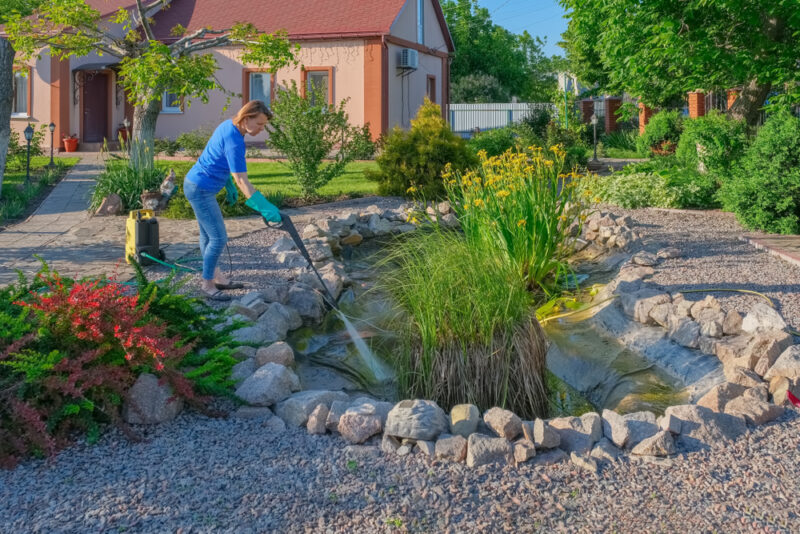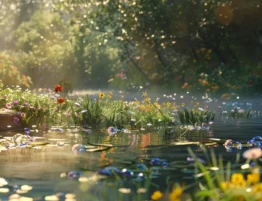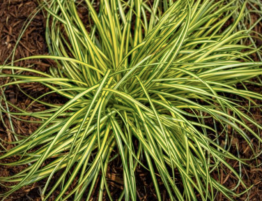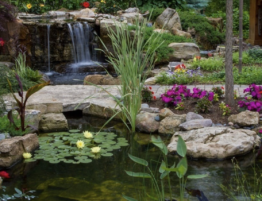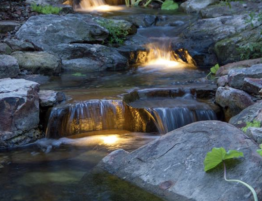
As temperatures drop in Missouri, pond owners face the challenge of preparing their ponds for winter. Proper winter pond maintenance ensures your fish stay safe, your water features function smoothly, and your pond remains healthy throughout the cold months.
This guide will address all your concerns, from preventing freezing to ensuring koi fish and plants survive the winter.
Let’s dive into how to winter-proof your pond in just 4 easy steps!
Why Winter Pond Care Matters
Missouri winters bring freezing temperatures that can severely impact ponds if they are left unattended. Ice buildup can restrict oxygen flow, damage pond pumps, and threaten fish survival. Winter-proofing your pond ensures:
- Fish Safety: Prevents oxygen depletion and freezing hazards.
- Pond Equipment Protection: Prolongs the lifespan of pumps, filters, and heaters.
- Healthy Ecosystem: Keeps plants and fish alive and thriving into spring.
Get Your Pond Ready for Winter In 4 Easy Steps
Step 1: Clean Your Pond Before Winter
Start winter maintenance by giving your pond a thorough cleaning. Leaves, debris, and organic matter can decay during winter, leading to toxic gas buildup that harms fish.
Here’s how to clean your pond:
- Skim the Surface: Remove leaves and debris using a net or skimmer.
- Trim Aquatic Plants: Cut back dead foliage to prevent decay.
- Vacuum the Bottom: Use a pond vacuum to clean sludge and debris.
- Check for Leaks: Repair any pond liner tears or leaks before temperatures drop.
Our Pro Tip: Install a pond net in the fall to catch leaves and make cleanup easier.
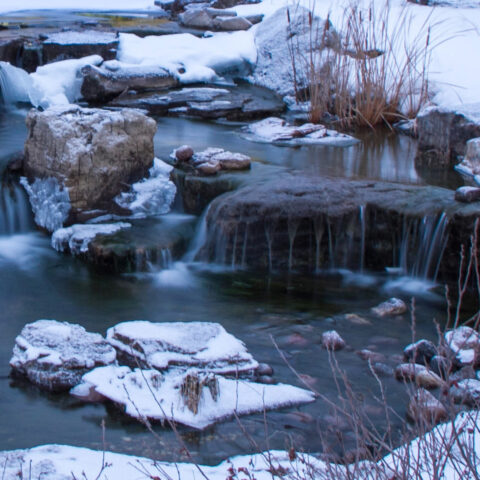
Step 2: Protect Your Fish During Winter
Fish, especially koi and goldfish, slow their metabolism in cold weather but still need oxygen to survive. Ensuring proper oxygen flow and temperature regulation is key to winter fish care.
- Install a Pond Aerator
Pond aeration during winter keeps oxygen levels high and prevents ice from sealing the surface.- Position the Aerator: Place it in shallow water to avoid disturbing fish resting in the pond’s deeper areas.
- Benefits: Prevents stagnant water, supplies oxygen, and reduces harmful gases.
- Use a Pond Heater or De-Icer
A pond heater or de-icer keeps a small area of the pond’s surface ice-free, allowing oxygen exchange.- Choose Energy-Efficient Models: Look for floating pond de-icers that operate efficiently.
- Placement: Position the heater near the pond’s edge, away from fish resting zones.
- Feed Fish Properly
As temperatures drop:- Stop Feeding Below 50°F: Fish cannot digest food in cold water, which can harm them.
- Use Cold-Weather Fish Food: If feeding in fall, switch to wheat-germ-based food for easier digestion.
Warning: Avoid breaking ice with force, it can shock and stress fish. Use a de-icer agent instead.

Step 3: Maintain Pond Equipment in Winter
Winter conditions can damage pumps, filters, and other pond equipment. Taking precautions now saves costly repairs later.
- Winterize Your Pond Pump
- Submersible Pumps: Either run the pump throughout winter to prevent freezing or remove it entirely.
- External Pumps: Drain and store pumps indoors to prevent freezing.
- Check Filters
- Clean biological and mechanical filters before winter.
- Turn off filters that are prone to freezing.
- Protect Pipes and Water Features
- Fountains and Waterfalls: Shut down and drain water features to prevent ice damage.
- Pipes: Use insulation or pipe sleeves to avoid freezing.
Our Pro Tip: If you leave pumps running, redirect water flow to ensure no splashing causes ice buildup.

Step 4: Care for Pond Plants in Winter
Many aquatic plants require special care to survive winter.
- Hardy Plants: Trim dead leaves and submerge plants in the deepest part of the pond to keep them insulated.
- Tropical Plants: Remove and overwinter indoors in a water container.
- Floating Plants: Remove hyacinths and lettuce before frost sets in, as they won’t survive freezing.
Our Pro Tip: Hardy lilies can survive winter if the roots are submerged below the freezing line.
Common Pond Owner Concerns in Winter (FAQs)
Keep Your Pond Thriving All Winter Long
Winterizing your pond ensures a healthy ecosystem, protects your fish, and prevents costly damage to pond equipment.
By following these steps: cleaning, aerating, insulating, and monitoring your pond you can enjoy peace of mind knowing your pond is well-prepared for Missouri’s coldest months.
Need help winter-proofing your pond? Clarity Ponds specializes in pond maintenance and winter preparation in St. Louis and surrounding areas. Contact us today to schedule a professional pond winterization service!

